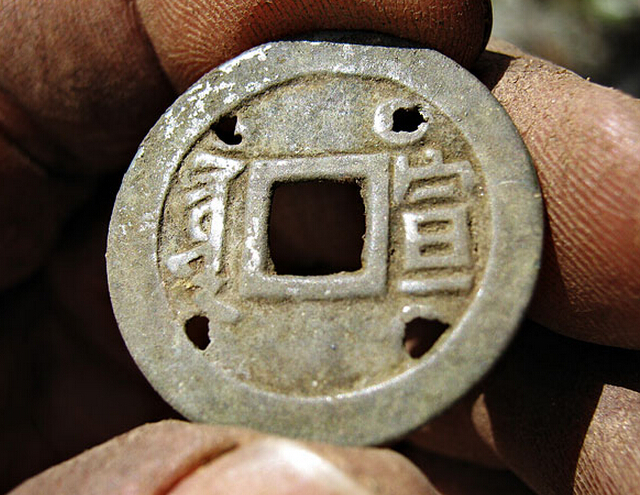Chinese coin presents riddle in Yukon bush
From:Yukon News NetWriter:John ThompsonDate:2015-09-11
A 300-year-old Chinese coin discovered in the Yukon bush this summer is raising tantalizing questions about trade connections that long predated the Klondike Gold Rush.The coin, minted between 1667 and 1671, appears to have been carried into the Yukon’s interior long before stampeders headed for Dawson City in 1898.
It was discovered near stone chips - a sign of prehistoric tools being sharpened - while no whisky bottles, tin cans or other historic artifacts were found nearby.

Mario Skookum of the Little Salmon Carmacks First Nation looks at one of the Chinese coins while Kirby Booker, an archaeologist with Ecofor Consulting Ltd., sifts through dirt.
James Mooney, an archeologist who led the team that found the coin, suspects it was carried in by coastal Chilkats, who regularly travelled from Dyea to Selkirk to trade with the Northern Tutchone.
The coin was discovered along that route in July, at a site 240 kilometres northwest of Whitehorse. Mooney works for Ecofor Consulting, which had been hired by Western Copper and Gold to look for heritage sites near its proposed Casino mine.
Mooney spotted the coin shortly after fellow archeologist Kirby Booker turned the first shovel of topsoil. “The very first thing we found was this coin,” said Mooney. “It’s just amazing.”

This 17th-century Chinese coin was found at the Casino minesite.
They chose to dig at the site because it looked like a perfect camping spot.
It overlooked a confluence of a river and a creek. It had enough wind to not be buggy. And it wasn’t far from water.
“You’d want to set up your tent there,” said Mooney.
He suspects that Russian traders served as intermediaries between the Chilkats and Chinese. Russian trade along the Pacific Northwest is known to have occurred as early as the 1740s. They came for furs - primarily sea otter, but also seal, fox, beaver, lynx and marten.
“The Russians would make this loop,” said Mooney. “They’d come down, take the furs, trade with the First Nations, and then go back up to Southeast Asia and trade for glass beads, silk, other cloth, coinage and other metals.”
The Tlingit came to value Chinese coins, sometimes as trinkets and charms, but more often for a more practical purpose. They used them to make armour, by sewing them in overlapping patterns.
One Tlingit warrior’s coin-laden vest is now on display at the American Museum of Natural History, after it was collected by the famous anthropologist, Franz Boaz.
Chinese coins are minted with holes in their centres, which proved handy for sewing on to clothes. The coin discovered by Mooney’s team also had four smaller holes drilled in each corner - another hint it may have been attached to clothing, said Mooney.
Chilkats had a reputation for ferocity. They pillaged Fort Selkirk in 1852 and chased off its founder, Robert Campbell, after he disrupted their trade monopoly with the Northern Tutchone.
“There’s no evidence to say this coin was not associated with that raid,” Mooney said with a chuckle. “We don’t really know the true use of the coin, but the coin may have been used.”
The coin’s age is known because it bears the name of the reining Chinese emperor of the day: Kangxi, fourth emperor of the Qing dynasty.
The coin is 60 per cent copper, 40 per cent zinc. No tests were needed to ascertain this information. China kept detailed records at its mints, which were matched with characters on the coin.
Two other old Chinese coins have been found in the territory. One, found near Beaver Creek by Keary Walde in 1993, dates to 1403-1424.
Until recently, the coin was believe to have been minted in the 1880s. But, after Mooney made his find, he checked the ages of the other coins with Gary Ashkenazy, an expert in old Chinese coins.
“He said, ‘That coin from Beaver Creek isn’t from the 1880s. It’s from 1403 to 1423. I just about died.”
That site also appears to have predated the Gold Rush. Yet the coin was found with pig bone.
“That’s also an oddity, because there was no pig in the Yukon at that time,” said Mooney.
Perhaps the ancient coin was traded in long after it was minted. Or, Mooney wonders, perhaps the Chinese visited the West Coast before Europeans did.
That’s the thesis of Gavin Menzies’ bestselling book, 1421: When China Discovered America. Professional historians have dismissed the theory as conjecture based on flimsy evidence.
“There’s a lot of controversy surrounding the book,” said Mooney. “But, at the time, China did have large sailing vessels. And they were getting around. I think we may have some evidence that adds to the really early side of things. Some of this may have been from those early expeditions.”
Mooney plans to partner with the two others who discovered old Chinese coins in the Yukon to write an academic paper.
As for the coin, it belongs to the Yukon public and will be handed over to the territory’s heritage branch.

